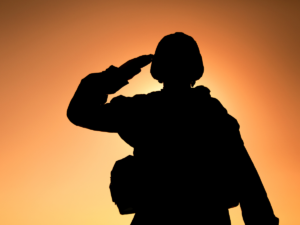Serving the Whole Community: Including Veterans in Your R&R Efforts
November 7, 2023
 November 11 is Veterans Day, a celebration to honor America’s veterans for their service, dedication, and sacrifice. The theme for Veterans Day 2023 is “Service.” This week, consider how your department supports and recognizes your current and potential members who have served in the U.S. military.
November 11 is Veterans Day, a celebration to honor America’s veterans for their service, dedication, and sacrifice. The theme for Veterans Day 2023 is “Service.” This week, consider how your department supports and recognizes your current and potential members who have served in the U.S. military.
Joseph Danao is the deputy commissioner of the Connecticut Department of Veterans Affairs, a fire instructor, a volunteer firefighter/EMT, and a member of the National Volunteer Fire Council’s SAFER Work Group, among other positions. He provided his insight on how volunteer firefighters and emergency services personnel can recruit and retain veterans in their organization.
Tell us about your background and where you are now.
I entered the Connecticut Army National Guard in 1982. This involved attending basic training and advanced individual training in South Carolina and Georgia. After training ended, I returned to what we called “fort living room” in Connecticut. Throughout 1983 I wanted to do more for my community, so I decided to follow a few friends who were members of a volunteer fire department. I retired from the Connecticut Army National Guard in 2015 at the rank of Lieutenant Colonel and still have not retired from that same volunteer fire department; 2023 is my 40th year of volunteer fire/EMS service.
Currently, I am also the deputy commissioner of the Connecticut Department of Veterans Affairs. It is an excellent assignment that allows me to continue serving my fellow service members in Connecticut. I still have the flexibility to volunteer as an EMT and firefighter as well as serve on multiple volunteer public service committees.
My military service comes in handy in all aspects of my professional life, whether on the job or at the fire department.
How do you think your unique background as a military service member informs your work in the fire service?
Military service brings a level of commitment, selfless service, regard and respect for authority, and hyper-focus on the well-being of others that is not packaged and taught anywhere else. Self-discipline to do the right thing even when no one is looking helps keep us true to our mission and each other. In the military, it’s about survival, and the fire service is no different.
How is fire & EMS recruitment outreach the same or different for veterans as compared to other communities?
Recruiting veterans is a no-brainer – they are accustomed to hard work and adhering to standards whether they served one year or thirty. According to the U.S. Department of Veterans Affairs, the United States has approximately 18,250,044 veterans. Of these, approximately 4,000,000 are between 17 and 45 years of age, and about 7,600,000 veterans are between the ages of 45 and 70 years old.
The challenge for recruitment and retention is to reach out to this multigenerational population with a trusted brand and message. For the younger generations, the excitement of serving on the frontline on trucks and in ambulances is like their military service. Recruitment efforts must still realize the veteran population who has “been there and done that” can come from any generation. You could look at a 50-year-old veteran who has the same life goals as someone who is 25 years old. What their life goals are is based on their experiences in their military service that come at any age from 17 to 80+.
How can emergency services organizations make their outreach more inclusive – and enticing – for veterans?
A common message of “service excellence for the benefit of the community.” Military veterans will always want to serve their country and community. There is no more meaningful way to continue serving than helping your community when they are in danger or ill. Veterans understand the phrase: “If not me, then who?”
Ensure they know their military service is unique and meaningful. Have an open front door and let veterans know what is expected of them upfront. They will look for standards, policies, and regulations. They will also need time to decide what they want to do in the department. They may even be new to the community and still unsure about their surroundings.
Build trust with veterans in the department and community. Trust is everything to a veteran.
How can organizations implement policies in their departments that support current members/volunteers who are veterans?
Here are some first steps:
- Always have an employee assistance program (EAP); if possible, one that specifically supports veterans.
- Ensure policies addressing equality and harassment are solid.
- Overall SOPs are important. Veterans look for standards and want to see them followed by others. For instance, veterans will follow standards on when and how to wear PPE and a seatbelt and expect adherence to the same from all ranks.
How can organizations reach and connect with veterans at the local level?
Engage with your state’s Department of Veterans Affairs by visiting their web site and local representatives. They may have information useful to your department. Depending on the local population of veterans, a fire/EMS department should consider hosting a veterans benefit event in the evening or weekend. And always include food with any veterans’ event!
Any other thoughts or resources you’d like to share?
When I deployed to Afghanistan in 2010, I was fortunate to lead a spectacular team focused on rebuilding a nation and leaving them with the capacity to maintain it themselves. This included designing and building multiple firehouses. No matter where the firefighters were from, we had instant mutual respect as fellow firefighters and me as a chief officer. I remember one time after a terrible incident involving more than 30 people, I came across the responding fire crew. We talked about the trauma of making mass casualty treatment and triage decisions. Although I spoke their language in a broken manner, they fully understood we shared the same anguish over not being able to save everyone. It was a moment I will never forget, a moment of instant bonding. I think of that encounter with that fire crew every day; I hope our few hours together helped them. I would want to think they are still on the frontline helping their community as I am mine.



